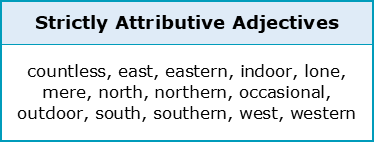What are the five rules of ordering adjectives?

This is the fourth of five chapters about Adjectives. To complete this reader, read each chapter carefully and then unlock and complete our materials to check your understanding.
– Explain why it’s important to pay attention to adjectival rules
– Introduce five rules for using adjectives grammatically
– Provides diagrams, tables and examples to help guide the reader
Chapter 4
While we’ve already discussed a number of important rules for correctly determining the forms and functions of adjectives in Chapters 1, 2 and 3, this fourth chapter next aims to explore five additional rules that, if followed, can help to improve academic success. Each of the five considerations below have been provided for you with explanations and examples that can be referred back to in the future.
Rule 1: Strictly Attributive Adjectives
As was explained in some detail in Chapter 3, attributive adjectives are those that most often directly precede the noun they modify. Contained within a larger noun phrase, attributives usually perform the phrase function of the subject or object of a clause. Predicative adjectives on the other hand are used within the complement that follows a copula or other linking verb. While many adjectives may be either attributive or predicative depending on their use and meaning, there are some adjectives that students should try to avoid using within predicative constructions. If you wish to be grammatical in you language use, remember that the following adjectives are strictly attributive:

Rule 2: Strictly Predicative Adjectives
Likewise, some adjectives are only grammatical when used in predicative constructions following copula or linking verbs:

Rule 3: Intensifying Adjectives
While adjectives such as ‘complete’ in the expression ‘a complete idiot’ may be used to intensify nouns (as explored in Chapter 1), adjectives themselves may be intensified through the addition of words such as ‘extremely’, ‘really’ or ‘very’ – as in, ‘he’s a very fat person’.
Rule 4: Coordinating Adjectives
Slightly more complicated than the three previous rules is when attempting to use more than one adjective in a row, such as in the expression ‘this is going to be a hot, dry summer’. Notice in the previous example that the adjectives ‘hot’ and ‘dry’ are both modifying the noun ‘summer’, are both placed in a particular order, and are both coordinated with a comma (,). Coordinate adjectives such as these may in fact be coordinated with either a comma or with the conjunction ‘and’, as is shown in the following examples:

There are some adjectives, however, that may appear to coordinate like this but would be ungrammatical if a comma or ‘and’ were included. For non-coordinate expressions such as those provided below, it’s the adjective closest to the noun that modifies that noun (as in ‘gold watch’), while the first adjective (‘new’) modifies that noun phrase (‘new gold watch’). Because these adjectives do not coordinate, they should not take a comma or an ‘and’:

Clearly then, the noun phrases ‘gold watch’ and ‘wooden table’ in these examples are being modified by the adjectives ‘new’ and ‘worn’ respectively. We can determine that these are not coordinate adjectives because you cannot place an ‘and’ between them, as in ‘the new and gold watch’.
Rule 5: Ordering Adjectives
Finally, and perhaps most importantly, is the question of how to correctly order adjectives. We’ve already discussed how more than one adjective can be used to modify the same noun, but what many students don’t know is that there’s also a particular order that must be followed when listing multiple adjectives together. As is demonstrated in the two expressions provided below, the descriptive categories that decide this order include features such as the size, age or material of an item:

There are nine of these semantic categories that students should learn to use if they wish to improve their chances of academic adjective success. While it might be quite unnatural to ever create or use an expression that includes every one of the nine categories listed below, this table can still be used (and later referred to) when confidently determining how to order your adjectives:

Having now explored the functions, types and rules of adjectives, our fifth and final chapter on this topic introduces you to the adjectives and phrases that are most useful when writing academically.
Downloadables
Once you’ve completed all five chapters about adjectives, you might also wish to download our beginner, intermediate and advanced worksheets to test your progress or print for your students. These professional PDF worksheets can be easily accessed for only a few Academic Marks.
Collect Academic Marks
-
100 Marks for joining
-
25 Marks for daily e-learning
-
100-200 for feedback/testimonials
-
100-500 for referring your colleages/friends